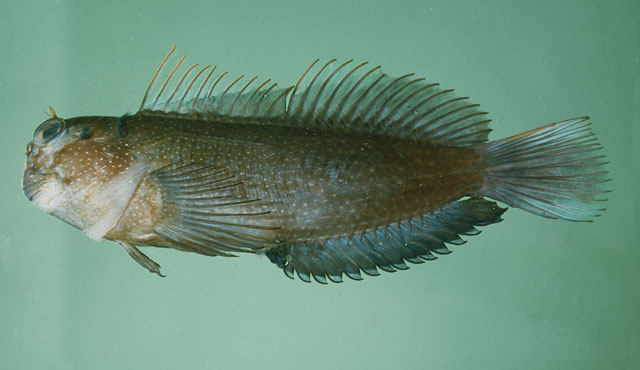| Blenniidae (Combtooth blennies), subfamily: Salariinae |
| 15.5 cm NG (male/unsexed) |
|
reef-associated; marine; depth range 0 - 10 m |
| Pacific Ocean: Capricorn Group of the Great Barrier Reef, Lord Howe, Norfolk, Kermadec, Cook, Austral and Easter islands; also from the Pitcairn Group. |
|
Dorsal spines (total): 12-12; Dorsal soft rays (total): 15-17; Anal spines: 2-2; Anal soft rays: 16-18; Vertebrae: 31-32. Diagnosis: Dorsal fin XII, 15-17 (usually 16), deeply incised above the last spine; anal fin II, 16-18 (usually 17); pectoral rays 14-16 (in general for the genus); pelvic fin I, 4; caudal fin procurrent rays 10-14. Gill rakers 25-31. Vertebrae 10 + 21-23 (usually 22); last pleural rib on 12th, last epipleural rib on 18th-23rd vertebral centrum. Body scaleless. Lateral line, anterior portion with small scalelike flaps, LL tubes 11-17 (rarely 9-10), series ends below and posterior to dorsal fin ray 12. Narrow inner ring of iris yellow, remainder black. Lower lip crenulated mesially, plicate laterally. Upper lip crenulae 34-52. Cirri, nuchal 28-42, supraorbital 4-18, nasal 8-27. Nuchal cirri in 2 groups, not overlapping at midpoint of nape, no nuchal flaps. First and second dorsal fin spine almost same height. Species name (albus - white; apicalis - apex) refers to pale tips of dorsal-fin spines. Adult brown in body color with spots; brown pupil-sized spot behind each eye. Ophioblennius stage overall light brown; lower lip both corners with dark spot; cirri brown; fins pale (in alcohol); dentary with 2-4 canines posteriorly (Ref. 529). |
| Found in coral reefs and rocky reefs (Ref. 529). Oviparous. Eggs are demersal and adhesive (Ref. 205), and are attached to the substrate via a filamentous, adhesive pad or pedestal (Ref. 94114). Larvae are planktonic, often found in shallow, coastal waters (Ref. 94114). |
|
Least Concern (LC); Date assessed: 24 March 2009 Ref. (130435)
|
| harmless |
Source and more info: www.fishbase.org. For personal, classroom, and other internal use only. Not for publication.

